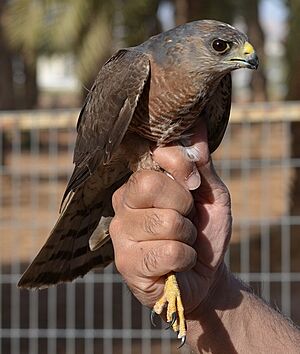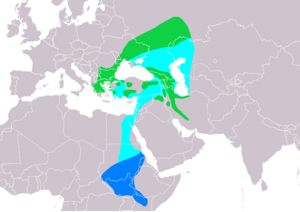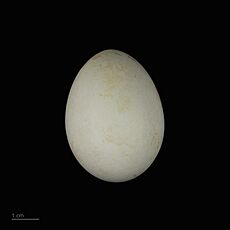Levant sparrowhawk facts for kids
Quick facts for kids Levant sparrowhawk |
|
|---|---|
 |
|
| Conservation status | |
| Scientific classification | |
| Genus: |
Accipiter
|
| Species: |
brevipes
|
 |
|
| Range of A. brevipes Breeding Non-breeding Passage | |
The Levant sparrowhawk (Accipiter brevipes) is a small bird of prey. These birds are also known as raptors. They are about 32–38 cm (13–15 in) long. Their wings can spread out to 65–75 cm (26–30 in) wide.
Female Levant sparrowhawks are larger than males. But the size difference is not as big as in some other hawk species.
Adult male hawks have blue-grey feathers on their backs. Their wingtips are dark, and their undersides are reddish with bars. Adult females have slate-grey backs and dark wingtips. Their undersides are reddish-brown with bars. Young hawks are dark brown on top. Their undersides have dark streaks. They also have a dark line on their throat.
These birds build nests in forests. They live from Greece and the Balkans all the way to southern Russia. They are migratory birds. This means they fly to warmer places for winter. They spend winter from Egypt to southwestern Iran.
Levant sparrowhawks migrate in large groups. This is different from the more common Eurasian sparrowhawk. They hunt small birds, insects, rodents, and lizards. They often surprise their prey by flying quickly from a hidden spot.
Contents
About the Levant Sparrowhawk
This hawk is a small raptor. It has short, wide wings and a long tail. These features help it fly easily through trees. It looks a bit like the Eurasian sparrowhawk. However, its shorter tail and more pointed wings make it look more like a falcon.
The way this hawk flies is special. It does a "flap – flap – glide" motion. Its call is a sharp sound that sounds like "kee-wick."
What's in a Name?
The Levant sparrowhawk was first described in 1850. It belongs to a group of birds called Accipiter. The name Accipiter comes from a Latin word. It means "hawk" or "to grasp."
The second part of its scientific name, brevipes, also comes from Latin. Brevis means "short" and pes means "foot." This name refers to the hawk's short toes.
Appearance of the Levant Sparrowhawk
The Levant sparrowhawk is small for a raptor. It measures 32–38 cm (13–15 in) long. Its wingspan is about 65–75 cm (26–30 in). Female birds are larger than males. This is common in many raptor species.
Adult male hawks are blue-grey on their backs. Their undersides are pale. Their belly and leg feathers have fine reddish and white bars. Their head is also blue-grey. They have a white throat with a faint dark stripe down the middle.
Female hawks look similar. But their feathers are usually a darker brownish-grey. Both male and female hawks have orangish-yellow legs. They also have a yellow cere, which is the fleshy part above their beak.
Life Cycle and Behavior
Breeding and Nests
Levant sparrowhawks breed from mid-May to August. During this time, a pair will protect their territory. They often fly high in the sky in circles.
The female hawk usually builds the nest. She makes a new one every year. The nest is a small structure made of twigs. It is built on a branch or in a fork of a broad-leaved tree. They often choose trees near water. These trees might be in open woodlands or at the edge of a forest.
The nest is about 30 cm (12 in) wide and 15 cm (5.9 in) deep. The female lines it with fresh green leaves. Most nests are built 5–10 m (16–33 ft) above the ground. Some have been found as low as 4 m (13 ft) or as high as 20 m (66 ft).
The female lays 2–5 eggs. She sits on the eggs alone for 30–35 days to keep them warm. The eggs hatch at different times. The young hawks stay in the nest for about 40–45 days. They become independent about 15 days after leaving the nest.
Flight and Migration
Levant sparrowhawks can flap their wings constantly. But when they migrate, they usually soar and glide. They also use warm air currents called thermals to help them fly. Sometimes, they can even hover in the air.
Population and Safety
In Armenia, there are an estimated 180–220 pairs of Levant sparrowhawks that breed.
The Levant sparrowhawk is listed as a species of least concern. This means its population is stable and its range is very large. So, it is not currently at high risk of disappearing. However, new wind farms might affect their numbers in some areas.



